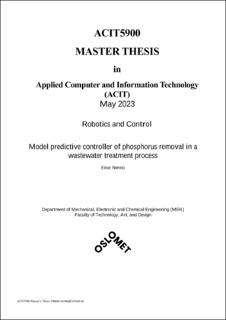| dc.description.abstract | Historically, poor sanitation has always been a concern as it causes diseases such as cholera, intestinal worm infections, polio, typhoid, and dysentery. Sanitation problems are still a pressing issue for many people around the world. Developing an energy and cost-effective wastewater treatment and water resource recovery facility that could potentially be scaled up for a wider adoption would be a virtues pursuit. The Hias process uses biofilm carriers in anerobic and aerobic basins that absorbs the nutrients that comes into the wastewater treatment facility. This enhanced biological phosphorus removal (EBPR) process is being performed in moving-bed bioreactor (MBBR). It is able to remove 90% of phosphorus or polyphosphate (PO4-P) from the wastewater. Hias IKS Wastewater treatment and water resource recovery facilities (WRRF) is an end user in PACBAL research project lead by Tiina Komulainen, which is the main supervisor for this master’s thesis. Control strategies in a wastewater treatment plant is crucial, as it allows for efficient management of the water purification process to safeguard our environment. The focus and goal for this master’s thesis is to improve the Hias process energy efficiency by implementing advanced control strategies. Developing the traditional industry standard control strategy, the Proportional-integral-derivative (PID) controller, will be compared against the novel approach of a model predictive controller (MPC) in the Hias process. The MPC designed in this project achieved better results than the PID when it comes to disturbance rejection, set point tracking and energy efficiency. However, the PID utilizes simpler control structures and has lower computational time than the MPC. This is often more desirable for industrial implementation. The development of these control strategies is an important step towards industrial implementation. The control strategies are based on transfer functions derived by system identification of the online data provided for the Hias process. The datasets contained online measurements of soluble chemical oxygen demand (SSins)-, flowrate of wastewater (FS)- and NO2/NO3 (NOX) in the inlet. It also contained flow rate of oxygen (FO)- and dissolved oxygen (SO) in the aerobic basins. The datasets also contained polyphosphate that comes out the disc filter (SPOd). These variables will be simulated as virtual sensors by utilizing Matlab Simulink. The preprocessing of the datasets achieved adequate correlation between the variables used for the transfer functions. While the dynamic linear models obtained from the system identifications gave sufficient results for control strategy implementation. The chapters in this thesis will first describe the first part of the project which is the data preprocessing of the online data. Then the system identification to obtain the dynamic linear models represented as transfer functions will be discussed for each chapter. The control strategies developed based on the transfer functions will be the last part of each section. | en_US |
